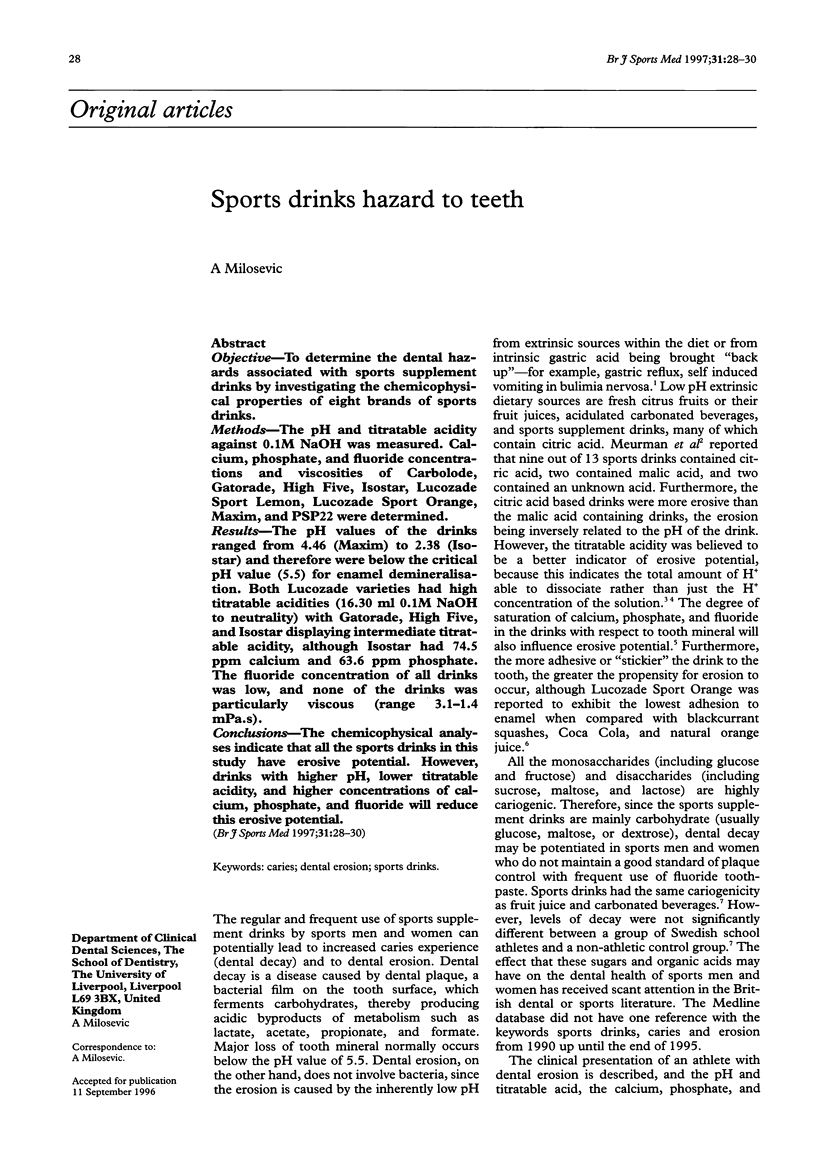Abstract
OBJECTIVE: To determine the dental hazards associated with sports supplement drinks by investigating the chemicophysical properties of eight brands of sports drinks. METHODS: The pH and titratable acidity against 0.1 M NaOH was measured. Calcium, phosphate, and fluoride concentrations and viscosities of Carbolode, Gatorade, High Five, Isostar, Lucozade Sport Lemon, Lucozade Sport Orange, Maxim, and PSP22 were determined. RESULTS: The pH values of the drinks ranged from 4.46 (Maxim) to 2.38 (Isostar) and therefore were below the critical pH value (5.5) for enamel demineralisation. Both Lucozade varieties had high titratable acidities (16.30 ml 0.1M NaOH to neutrality) with Gatorade, High Five, and Isostar displaying intermediate titratable acidity, although Isostar had 74.5 ppm calcium and 63.6 ppm phosphate. The fluoride concentration of all drinks was low, and none of the drinks was particularly viscous (range 3.1-1.4 mPa.s). CONCLUSIONS: The chemicophysical analyses indicate that all the sports drinks in this study have erosive potential. However, drinks with higher pH, lower titratable acidity, and higher concentrations of calcium, phosphate, and fluoride will reduce this erosive potential.
Full text
PDF


Images in this article
Selected References
These references are in PubMed. This may not be the complete list of references from this article.
- Borg A., Birkhed D. Dental caries and related factors in a group of young Swedish athletes. Int J Sports Med. 1987 Jun;8(3):234–235. doi: 10.1055/s-2008-1025662. [DOI] [PubMed] [Google Scholar]
- Grenby T. H., Mistry M., Desai T. Potential dental effects of infants' fruit drinks studied in vitro. Br J Nutr. 1990 Jul;64(1):273–283. doi: 10.1079/bjn19900028. [DOI] [PubMed] [Google Scholar]
- Ireland A. J., McGuinness N., Sherriff M. An investigation into the ability of soft drinks to adhere to enamel. Caries Res. 1995;29(6):470–476. doi: 10.1159/000262117. [DOI] [PubMed] [Google Scholar]
- Järvinen V. K., Rytömaa I. I., Heinonen O. P. Risk factors in dental erosion. J Dent Res. 1991 Jun;70(6):942–947. doi: 10.1177/00220345910700060601. [DOI] [PubMed] [Google Scholar]
- Larsen M. J. Chemical events during tooth dissolution. J Dent Res. 1990 Feb;69(Spec No):575–636. doi: 10.1177/00220345900690S114. [DOI] [PubMed] [Google Scholar]
- Lussi A., Jäggi T., Schärer S. The influence of different factors on in vitro enamel erosion. Caries Res. 1993;27(5):387–393. doi: 10.1159/000261569. [DOI] [PubMed] [Google Scholar]
- Meurman J. H., Härkönen M., Näveri H., Koskinen J., Torkko H., Rytömaa I., Järvinen V., Turunen R. Experimental sports drinks with minimal dental erosion effect. Scand J Dent Res. 1990 Apr;98(2):120–128. doi: 10.1111/j.1600-0722.1990.tb00950.x. [DOI] [PubMed] [Google Scholar]
- Milosevic A. Tooth wear: an aetiological and diagnostic problem. Eur J Prosthodont Restor Dent. 1993 Jun;1(4):173–178. [PubMed] [Google Scholar]




